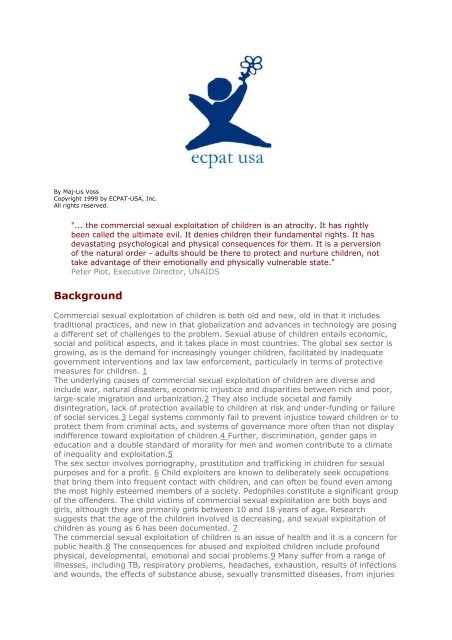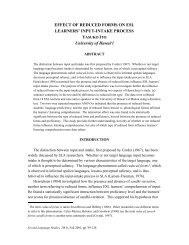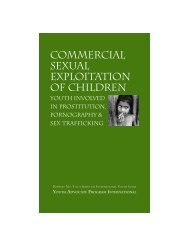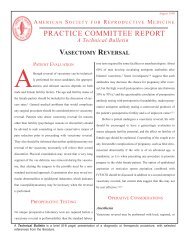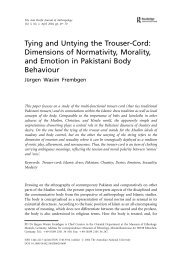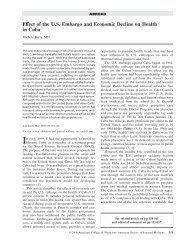Commercial Sexual Exploitation of Children: An Overview (PDF)
Commercial Sexual Exploitation of Children: An Overview (PDF)
Commercial Sexual Exploitation of Children: An Overview (PDF)
You also want an ePaper? Increase the reach of your titles
YUMPU automatically turns print PDFs into web optimized ePapers that Google loves.
By Maj-Lis Voss<br />
Copyright 1999 by ECPAT-USA, Inc.<br />
All rights reserved.<br />
"... the commercial sexual exploitation <strong>of</strong> children is an atrocity. It has rightly<br />
been called the ultimate evil. It denies children their fundamental rights. It has<br />
devastating psychological and physical consequences for them. It is a perversion<br />
<strong>of</strong> the natural order - adults should be there to protect and nurture children, not<br />
take advantage <strong>of</strong> their emotionally and physically vulnerable state."<br />
Peter Piot, Executive Director, UNAIDS<br />
Background<br />
<strong>Commercial</strong> sexual exploitation <strong>of</strong> children is both old and new, old in that it includes<br />
traditional practices, and new in that globalization and advances in technology are posing<br />
a different set <strong>of</strong> challenges to the problem. <strong>Sexual</strong> abuse <strong>of</strong> children entails economic,<br />
social and political aspects, and it takes place in most countries. The global sex sector is<br />
growing, as is the demand for increasingly younger children, facilitated by inadequate<br />
government interventions and lax law enforcement, particularly in terms <strong>of</strong> protective<br />
measures for children. 1<br />
The underlying causes <strong>of</strong> commercial sexual exploitation <strong>of</strong> children are diverse and<br />
include war, natural disasters, economic injustice and disparities between rich and poor,<br />
large-scale migration and urbanization.2 They also include societal and family<br />
disintegration, lack <strong>of</strong> protection available to children at risk and under-funding or failure<br />
<strong>of</strong> social services.3 Legal systems commonly fail to prevent injustice toward children or to<br />
protect them from criminal acts, and systems <strong>of</strong> governance more <strong>of</strong>ten than not display<br />
indifference toward exploitation <strong>of</strong> children.4 Further, discrimination, gender gaps in<br />
education and a double standard <strong>of</strong> morality for men and women contribute to a climate<br />
<strong>of</strong> inequality and exploitation.5<br />
The sex sector involves pornography, prostitution and trafficking in children for sexual<br />
purposes and for a pr<strong>of</strong>it. 6 Child exploiters are known to deliberately seek occupations<br />
that bring them into frequent contact with children, and can <strong>of</strong>ten be found even among<br />
the most highly esteemed members <strong>of</strong> a society. Pedophiles constitute a significant group<br />
<strong>of</strong> the <strong>of</strong>fenders. The child victims <strong>of</strong> commercial sexual exploitation are both boys and<br />
girls, although they are primarily girls between 10 and 18 years <strong>of</strong> age. Research<br />
suggests that the age <strong>of</strong> the children involved is decreasing, and sexual exploitation <strong>of</strong><br />
children as young as 6 has been documented. 7<br />
The commercial sexual exploitation <strong>of</strong> children is an issue <strong>of</strong> health and it is a concern for<br />
public health.8 The consequences for abused and exploited children include pr<strong>of</strong>ound<br />
physical, developmental, emotional and social problems.9 Many suffer from a range <strong>of</strong><br />
illnesses, including TB, respiratory problems, headaches, exhaustion, results <strong>of</strong> infections<br />
and wounds, the effects <strong>of</strong> substance abuse, sexually transmitted diseases, from injuries
esulting from violence inflicted either by those involved in controlling and organizing the<br />
sexual transactions, or resulting from self-harm. They may be malnourished or<br />
debilitated because <strong>of</strong> the inevitable hazards <strong>of</strong> a poor living environment, <strong>of</strong> poverty or<br />
from neglect. 10<br />
In the past, emphasis was placed on addressing the supply side <strong>of</strong> the phenomenon<br />
through, for example, anti-poverty measures, social development and income generation<br />
schemes for families.11 It is increasingly recognized, however, that the demand side is a<br />
crucial area <strong>of</strong> concern; the sex exploiters, the customers and the sex sector and its<br />
actors need to be targeted12 in developing measures to combat the problem.<br />
<strong>Children</strong> as Commodities<br />
In the industrialized countries, the structure and function <strong>of</strong> the family appear to be<br />
significant factors in children becoming victims <strong>of</strong> sexual exploitation.13 Economic<br />
inequalities, domestic violence and abuse, family disintegration, drug addiction, and lack<br />
<strong>of</strong> support structures and inadequate social services are increasingly recognized as<br />
factors leading to the spread <strong>of</strong> child prostitution, particularly among teenagers. It is<br />
known that there are increasingly large numbers <strong>of</strong> children employed in the sex trade in<br />
New York, London, Paris, Sydney and other major cities.14<br />
In the developing countries, macro social and economic factors appear to be important<br />
determinants. <strong>An</strong> increase has been noted in commercial sex in many countries<br />
undergoing structural adjustment; social, political and economic upheavals have caused<br />
an increase in economic disparities. In conditions <strong>of</strong> poverty and war, family breakdowns<br />
occur, exposing children to widespread and systematic abuse and leaving them isolated<br />
and vulnerable to exploitation.15 Many developing countries have in the recent past<br />
struggled with pr<strong>of</strong>ound changes caused by political and economic crises. Communities<br />
and families have been weakened, and poverty has become deeper and more intractable.<br />
<strong>Children</strong> from poor communities where economic prospects or opportunities are bleak or<br />
non-existent are most at risk, resulting in the emergence <strong>of</strong> large numbers <strong>of</strong> children<br />
and young people living or working on the streets.16<br />
Research and monitoring<br />
The extent and documentation <strong>of</strong> commercial sexual exploitation <strong>of</strong> children continues to<br />
be a challenge due to a lack <strong>of</strong> uniform definition <strong>of</strong> what child sexual exploitation entails.<br />
Few examples exist <strong>of</strong> rigorous research, existing data is characterized by a poor<br />
understanding and use <strong>of</strong> quantitative information. It has also been hampered by lack <strong>of</strong><br />
data presented within a cultural context and by the shifting global patterns in the sexual<br />
exploitation <strong>of</strong> children. Most countries collect information about children, but few are<br />
able to produce comprehensive up-to-date statistics on the health <strong>of</strong> their children. The<br />
data is commonly concerned with two age groups: children under five years <strong>of</strong> age,<br />
concentrating on health aspects, and adolescents over the age <strong>of</strong> fifteen, focusing on<br />
employment, sexuality and drug use. Researchers recommend that data be collected for<br />
the age group 5 - 15 years, especially with regard to information on violations <strong>of</strong> rights,<br />
exploitation or abuse, accidents and injuries, child homicides, and illnesses related to the<br />
work environment. According to UNICEF, "this failure to monitor the effects <strong>of</strong> economic<br />
and social changes on the most vulnerable is both a cause and a symptom <strong>of</strong> the lack <strong>of</strong><br />
political priority afforded to this task".17<br />
To ensure that children benefit from the protection international conventions have been<br />
designed to give, practical indicators are needed, based on reliable statistical data<br />
relevant to regional, national and local situations.18 Researchers argue that children's<br />
rights, and the responsibility <strong>of</strong> the government, community and family towards its<br />
children should be the starting point in developing a framework for measurement and<br />
monitoring.
Child pornography<br />
There is a substantial market for child pornography worldwide, and the increase in the<br />
production and distribution <strong>of</strong> child pornography has become easier and less risky due to<br />
the availability <strong>of</strong> more advanced and less expensive technology. 19 Child pornography is<br />
not only a commercial endeavor but there is considerable exchange and sharing <strong>of</strong><br />
material by individuals around the globe. There has been a major increase in the<br />
commercial production <strong>of</strong> child pornography since the early 1970s and computer bulletin<br />
boards and other on-line services have become a major avenue.20 In the 1980s, Europe<br />
was pointed to as the source <strong>of</strong> most pornographic films and photos, particularly<br />
Denmark and Holland. More recently, much <strong>of</strong> the industry has shifted to Eastern Europe<br />
and to Southeast Asia. Currently Japan is the largest producer and consumer <strong>of</strong> child<br />
pornography in the world, and the USA remains a major market for child pornography.<br />
Many web sites provide materials that are legal in the countries where they are created -<br />
- these are <strong>of</strong>ten societies which lack laws protecting children against kidnapping for<br />
sexual exploitation. In Asia alone, more than 100 web sites exist to promote teenage<br />
commercial sex.21 In 1995, studies in the United States documented one million on-line<br />
pornographic images involving children.<br />
<strong>Children</strong> who have been in the production <strong>of</strong> pornography commonly show a multitude <strong>of</strong><br />
symptoms, such as emotional withdrawal, anti-social behavior, mood swings, depression,<br />
fear and anxiety. A strong link has been noted between child pornography and child<br />
prostitution, and these children are at high risk <strong>of</strong> later becoming exploiters<br />
themselves.22<br />
Child prostitution<br />
Prostitution is one <strong>of</strong> the most alienating forms <strong>of</strong> child labor. Force is used to confine the<br />
children, and they can rarely seek help or be reached. They have no ability to negotiate<br />
the terms <strong>of</strong> their employment, they are commonly sold, trafficked, tricked or lured.23<br />
The child victims <strong>of</strong> the industry are most <strong>of</strong>ten from the poorest sections <strong>of</strong> society.<br />
Family or community members may knowingly sell children to brothel agents or pimps or<br />
unwittingly sell them into prostitution in the mistaken belief that the go-between will find<br />
them work in a factory or as domestic help.24 Some children are kidnapped or lured by<br />
traffickers with promises <strong>of</strong> employment only to end up in brothels.<br />
Child prostitution has become a multi-million dollar a year business; it is an organized<br />
industry with clients, traders, distribution routes and outlets, originating partly as a<br />
response to demand from tourists. International tourism has become a leading sector in<br />
world exports and is the biggest employer in the world: every 6th job in the world on<br />
average is somehow depending on or related to travel and tourism.25 Tourism is not the<br />
cause <strong>of</strong> sexual exploitation <strong>of</strong> children; it does, however, provide easy access to<br />
vulnerable children. Many US and European travel agencies set up sex tours for<br />
thousands every year. The flow <strong>of</strong> sex tourists is mainly from the economically developed<br />
world: to date, clients are mainly men from the U.S., Germany, Sweden, Australia, and<br />
Japan. In addition, the impact <strong>of</strong> local tourism is increasing and many customers are<br />
from neighboring countries.26<br />
International tourism organizations have been unanimous in condemning the use <strong>of</strong><br />
tourism for the purpose <strong>of</strong> sexual exploitation <strong>of</strong> children, and discussions are on-going<br />
on how the tourism industry can help bring an end to this practice.27 However, many<br />
countries struggling with weak economies rely on tourism as their primary industry, and<br />
while some countries view sex tourism as an unwanted but unavoidable part <strong>of</strong> tourism<br />
development, in many cases the governments directly tolerate sex tourism in pursuit <strong>of</strong><br />
economic development.28<br />
The symptoms experienced by child prostitutes are similar to those reported by other<br />
sexually abused children, such as depression, self destructive tendencies, inability to<br />
enter mainstream <strong>of</strong> society and ostracism.29 Child victims <strong>of</strong> prostitution may<br />
experience a lifetime <strong>of</strong> recurrent illnesses, such as venereal diseases, fertility problems,
pregnancy complications, malnutrition and tuberculosis.<br />
<strong>Children</strong> and AIDS: A Public Health Concern<br />
The demand for children for sex has increased dramatically in recent years,<br />
partly due to the belief that children are less susceptible to sexually transmitted<br />
diseases, and that sex with children is safer. To meet the demand for virgins,<br />
agents have intensified the recruitment <strong>of</strong> very young girls from remote villages<br />
and across borders, particularly in Asia. In reality, children are especially<br />
vulnerable. They are biologically more susceptible to sexually transmitted<br />
diseases, infections and injuries.<br />
<strong>Children</strong> involved in the sex trade face new and potentially fatal dangers in light<br />
<strong>of</strong> the spread <strong>of</strong> HIV/AIDS. 30 It is estimated that seven thousand young people<br />
aged 10-24 are infected with HIV every day. Researchers estimate that by the<br />
year 2000, ten million children will have been orphaned because <strong>of</strong> AIDS,<br />
placing a severe burden on health services. 31<br />
Child prostitutes may pose a greater public health danger than adult prostitutes,<br />
because children are weak, vulnerable and uninformed, and not in a position to<br />
seek out medical care if they become infected with a sexually transmitted<br />
disease. 32 They are an important link in the chain <strong>of</strong> transmission from the sex<br />
sector to the population at large because it involves clients who have<br />
unprotected sex with their spouses or others.<br />
The Scope <strong>of</strong> the Problem<br />
The illicit recruitment and sale <strong>of</strong> children across national borders, between developing<br />
and developed countries, and among developed countries is an organized industry<br />
ranging from small businesses to large enterprises. The business involves deception,<br />
kidnapping and enslavement, smuggling, false passports, bribery and corruption.<br />
Powerful interests control and maintain the structures within the sex sector.33 National<br />
case studies indicate that the sex sector continues to flourish partly because it is<br />
protected and supported by corrupt politicians, police, armed forces and civil servants<br />
who receive bribes, demand sexual favors and are themselves customers or owners <strong>of</strong><br />
brothels.34<br />
The growth <strong>of</strong> the sex sector is closely tied to economic progress and modernization, and<br />
it may be an intentional policy <strong>of</strong> some countries to promote prostitution as an economic<br />
activity. Government policies, such as for the promotion <strong>of</strong> tourism, migration for<br />
employment and the export <strong>of</strong> female labor are large and significant sources <strong>of</strong> foreign<br />
exchange earnings, and may have indirectly encouraged the growth <strong>of</strong> prostitution and<br />
sale and trafficking in children. 35 Other policies may also have led to the growth <strong>of</strong> the<br />
sex sector through their impact on poor families and the strategies adopted by them for<br />
survival, especially in the absence <strong>of</strong> social safety nets.<br />
Due to the criminal nature <strong>of</strong> the sex sector, precise figures on the number <strong>of</strong> children<br />
involved are difficult to obtain. In Asia, because groups working against the commercial<br />
sexual exploitation <strong>of</strong> children have been active for a relatively long time, data are more<br />
complete. The 1996 report <strong>of</strong> the United Nations Special Rapporteur on the Sale <strong>of</strong><br />
<strong>Children</strong>, Child Prostitution and Child Pornography estimates that about one million<br />
children in Asia alone are victims <strong>of</strong> the sex trade. According to the International Labor<br />
Organization, the problem is especially alarming in Korea, Thailand, the Philippines, Sri<br />
Lanka, Vietnam, Cambodia and Nepal.36<br />
<strong>Children</strong> are trafficked into India from Nepal and Bangladesh, and it is reported that<br />
children from Bhutan, India, Nepal and Sri Lanka are brought into Pakistan.<br />
Approximately 200-400 young Bangladeshi women and children are smuggled every<br />
month into Pakistan according to human rights activists. Young girls are being kidnapped<br />
in Nepal and shipped across the border to India; the Government <strong>of</strong> Nepal has reported<br />
that there are 200,000 Nepalese women and girls in India's brothels.37 In Thailand,<br />
victims have been abducted and brought to Myanmar, China, India and other countries.
Vietnam and Cambodia have serious problems <strong>of</strong> child prostitution and trafficking, and<br />
Sri Lanka's sex industry has seen an explosive growth in recent years.38<br />
According to the U.S. Department <strong>of</strong> Justice, prostitution in the U.S. is growing<br />
dramatically among young people; the problem <strong>of</strong> teenage prostitution is particularly<br />
acute. In Europe, trafficking is increasing rapidly, and the ages <strong>of</strong> the women and girls<br />
involved are decreasing. The problem is particularly severe in the East European<br />
countries; Defense for <strong>Children</strong> International has reported an alarming growth <strong>of</strong><br />
prostitution among Russian, Polish, Romanian, Hungarian and Czech children. Trafficking<br />
routes are extending and there is evidence to suggest that children are trafficked across<br />
continents and into the sex industries <strong>of</strong> industrialized countries such as Japan, Australia<br />
and throughout Scandinavia. 39<br />
In Africa, many countries are faced with a rising child prostitution problem and the<br />
linkage with tourism is evident. Algeria has been reported as a place <strong>of</strong> transit for<br />
traffickers, and Senegal, Kenya, Sudan and Libya are on the list <strong>of</strong> countries where child<br />
prostitution is increasing. Visible increases <strong>of</strong> children in prostitution are noted in Ghana,<br />
Cote d'Ivoire and Burkina Faso.<br />
In Central and South America, there are large numbers <strong>of</strong> street children and the link<br />
between that and prostitution is strong. Child victims <strong>of</strong> sexual exploitation are present in<br />
large numbers in Nicaragua, Venezuela, Bolivia, Chile, Ecuador, and Peru. In Brazil,<br />
UNICEF estimates that the number <strong>of</strong> prostituted children exceeds 500,000. The average<br />
age is 13-17, but there are cases <strong>of</strong> children as young as six documented in Brazil.40<br />
Concerns have been raised regarding the visible increase in child sex workers in<br />
Honduras, El Salvador, Mexico, Costa Rica, Panama, Guatemala and Argentina.<br />
International Efforts<br />
The international community is paying increased attention to the commercial sexual<br />
exploitation <strong>of</strong> children, and transnational and international governing bodies are<br />
involved in combating the problem.41 International conventions treat child prostitution<br />
as an unacceptable form <strong>of</strong> forced labor; the aim is to eradicate the practices and to find<br />
the right strategies to prevent problems from occurring in the first place. A number <strong>of</strong><br />
initiatives have been taken to protect the human rights <strong>of</strong> children, specifically ending<br />
prostitution, preventing gender discrimination, and providing children with rights.<br />
There is growing international acceptance <strong>of</strong> the need for more effective action and<br />
strengthened law enforcement in the countries <strong>of</strong> destination to which sex <strong>of</strong>fenders<br />
come.42 Extra-territoriality laws on the part <strong>of</strong> the countries <strong>of</strong> origin are being<br />
implemented to penalize the conduct <strong>of</strong> their nationals who commit crimes against<br />
children in other countries.43Inmost cases, in both international and national law, the<br />
legal stance is that the sale and trafficking in children, child prostitution and the sexual<br />
exploitation <strong>of</strong> children, pedophilia and child pornography are all violent crimes against<br />
children and are treated as such.44 How effectively these duties are carried out depends<br />
on the extent to which the society regards the protection <strong>of</strong> children as important; the<br />
legal environment reflects the political environment, and unless a society gives priority to<br />
the protection <strong>of</strong> its children, the laws will not protect them.45 In reality, child victims<br />
are <strong>of</strong>fered little or no protection as many laws suffer from lax or weak enforcement. The<br />
child victim is commonly penalized, while there are few consequences for the <strong>of</strong>fender.<br />
Non-governmental organizations have been instrumental in broadening international<br />
dialogue and expanding consensus for greater action. The International Labor<br />
Organization (ILO) and the United Nations have been at the forefront in the development<br />
<strong>of</strong> instruments to prevent child exploitation and forced labor. In 1959, the United Nations<br />
Declaration on the Rights <strong>of</strong> the Child proclaimed that "the child shall be protected<br />
against all forms <strong>of</strong> neglect, cruelty and exploitation. The child shall not be subject to<br />
traffic in any form." The most significant development with regard to protection <strong>of</strong><br />
children is the establishment <strong>of</strong> the United Nations Convention on the Rights <strong>of</strong> the Child<br />
in 1989, outlining children's human rights in civil, political, economic and cultural terms -<br />
- the child's right to survival and development.46
Article 34 <strong>of</strong> the Convention states that "the child has the right to be protected from all<br />
forms <strong>of</strong> sexual exploitation and sexual abuse. State Parties should take all appropriate<br />
measures to prevent the inducement or coercion <strong>of</strong> a child to engage in any unlawful<br />
sexual activity, the exploitation and use <strong>of</strong> children in prostitution or other unlawful<br />
practices, and the exploitative use <strong>of</strong> children in pornographic performances and<br />
materials". It requires that the laws in each country adopting the Convention must see<br />
children as the subjects <strong>of</strong> rights, not as commodities. Implementation <strong>of</strong> the Convention<br />
at the national level has been weak, however, due to inadequate law enforcement.47<br />
Moreover, attention to children's rights in particular and human rights in general is<br />
limited in many countries.<br />
Prior to the founding <strong>of</strong> the United Nations, a number <strong>of</strong> treaties were adopted in an<br />
effort to combat forced labor, trafficking, financial gains from the prostitution <strong>of</strong> others,<br />
and other forms <strong>of</strong> exploitation.48 Many recent international treaties, instruments and<br />
laws include direct references to the exploitation <strong>of</strong> children; others specify the<br />
obligations on the part <strong>of</strong> the State with regard to the treatment <strong>of</strong> children living in<br />
difficult circumstances (<strong>An</strong>nex 1). Further developments in international law are likely<br />
with the objective to create a binding instrument which bans the most intolerable forms<br />
<strong>of</strong> child labor, such as sexual exploitation <strong>of</strong> children. 49<br />
The World Congress Against <strong>Commercial</strong> <strong>Sexual</strong> <strong>Exploitation</strong> <strong>of</strong> <strong>Children</strong>, which took<br />
place in Sweden in 1996 was the first attempt to co-ordinate international co-operation<br />
and to draw international attention to the problem. The Declaration and Agenda for<br />
Action calls for full implementation <strong>of</strong> the Convention on the Rights <strong>of</strong> the Child. It was<br />
stated that "there is and can be no issue <strong>of</strong> choice, free will or self-determination in a<br />
situation <strong>of</strong> sexual exploitation, precisely because sexual exploitation is a suppression <strong>of</strong><br />
choice, eradication <strong>of</strong> free will and decimation <strong>of</strong> self-determination". 50<br />
Summary <strong>of</strong> Recommendations<br />
There is an urgent need for effective global action, strengthened law enforcement and<br />
law reform dealing with the commercial sexual exploitation <strong>of</strong> children.51 Appropriate,<br />
accessible, culturally appropriate, gender-sensitive services, including legal, social,<br />
medical, psychological and other support measures are essential. Psychological, social<br />
and medical interventions as well as long-term monitoring may be needed to treat the<br />
sex exploiter.52 Recommendations by the international community focus on, but are not<br />
limited to, the following:<br />
• strengthened multi-level international cooperation and collaboration between<br />
government and non-government sectors;<br />
• improved protection <strong>of</strong> children and their rights, and awareness raising <strong>of</strong><br />
children's rights;<br />
• strengthened public information campaigns to target the demand side, the sex<br />
exploiters;<br />
• strengthen and implement extraterritorial criminal laws, extradition and other<br />
measures to prosecute the sex exploiter <strong>of</strong> children, criminalize child<br />
pornography, including its possession, and register sex <strong>of</strong>fenders;<br />
• ensure effective law enforcement in both countries <strong>of</strong> origin and destination, and<br />
facilitate the gathering <strong>of</strong> evidence, detection and prosecution <strong>of</strong> sex exploiters by<br />
fostering cooperation between countries;<br />
• allocate adequate resources and capacity-building for preventive action against<br />
sexual exploitation <strong>of</strong> children;<br />
• increase access to basic education, particularly with regard to the plight <strong>of</strong> the girl<br />
child and the inferior status assigned to women and children in many<br />
communities;<br />
• conduct information campaigns on human sexuality and reproductive health;<br />
• provide comprehensive services to support child victims and their families, and<br />
protect child victims from being penalized; and
• develop alternative means <strong>of</strong> livelihood for child victims and their families to<br />
prevent further commercial sexual exploitation.<br />
Conclusion<br />
The commercial sexual exploitation <strong>of</strong> children involves coercion and violence, forced<br />
labor and is a contemporary form <strong>of</strong> slavery.53 Inadequate institutional mechanisms to<br />
promote children's rights, or lack there<strong>of</strong>, are predisposing factors in exposing children to<br />
various forms <strong>of</strong> exploitation. Oppressive aspects <strong>of</strong> tradition, societal assumptions about<br />
gender, sexuality, the need to police a woman's sexuality, and the low value placed on<br />
women and girls put young girls in a particularly vulnerable position.<br />
The problem <strong>of</strong> children involved in the sex sector is described in many countries as a<br />
problem imported from other cultures, sometimes in an attempt to take away attention<br />
from domestic policies and the root causes <strong>of</strong> poverty, marginalization and the<br />
indifference to the welfare <strong>of</strong> children. It is, however, the poor who are most vulnerable<br />
to sexual exploitation. Moreover, the poor are not only defined in terms <strong>of</strong> lack <strong>of</strong> access<br />
to employment, goods and services, but also more specifically through their lack <strong>of</strong><br />
access to power.54 In this hierarchy, in both developed and developing countries,<br />
children are on the bottom.<br />
The economic and social bases for prostitution remain strong in many developing<br />
countries. Although absolute poverty has declined, social safety nets are still largely<br />
absent, income inequalities remain wide, and child protection mechanisms are ineffective<br />
or non-existent. <strong>Sexual</strong>ly exploited children frequently fall outside the social welfare net.<br />
It is crucial that legislators and policymakers adopt a clear position on children in the sex<br />
sector.55 A major hurdle is that "they have shied away from directly dealing with it as an<br />
economic sector, and coherent and effective government policies and programs targeting<br />
the business are lacking".56<br />
In view <strong>of</strong> the differences between child prostitution and adult prostitution, separate<br />
measures for each, rather than a single policy stance, are recommended. Child sex<br />
workers should be treated as a much more serious problem than adults because children<br />
are clearly more vulnerable and helpless against the established structures and vested<br />
interests in the sex sector, and much more likely to be victims <strong>of</strong> debt bondage.<br />
There are few doubts that the sexual exploitation <strong>of</strong> children results in serious, <strong>of</strong>ten lifelong<br />
or life-threatening consequences for physical, psychological, and social<br />
development, including the threat <strong>of</strong> early pregnancy, maternal mortality, injury,<br />
retarded development, physical disabilities and sexually transmitted diseases, including<br />
HIV/AIDS.58 At the community level, the commercial sexual exploitation <strong>of</strong> children<br />
represents an erosion <strong>of</strong> human values and rights. When children lack a healthy<br />
environment, access to health care, education and recreation, and minimum standards <strong>of</strong><br />
food, clothing and shelter, they become particularly vulnerable to exploitation. The<br />
Convention on the Rights <strong>of</strong> the Child reaffirms that people under the age <strong>of</strong> 18 are<br />
entitled to full protection from all forms <strong>of</strong> commercial exploitation by adults. The<br />
commercial sexual exploitation <strong>of</strong> children is a fundamental violation <strong>of</strong> children's rights -<br />
the goal is to eradicate these practices and to ensure that children are given equal<br />
human rights.59<br />
<strong>An</strong>nex 1<br />
International Treaties, Laws and Instruments<br />
United Nations Treaties<br />
1923 Convention for the Suppression <strong>of</strong> the Circulation <strong>of</strong>, and Traffic in, Obscene<br />
Publications (amended in 1947)
Notes<br />
1949 Convention for the Suppression <strong>of</strong> the Traffic in Persons and the <strong>Exploitation</strong><br />
<strong>of</strong> the Prostitution <strong>of</strong> Others<br />
1956 Supplementary Convention on the Abolition <strong>of</strong> Slavery, the Slave Trade and<br />
Institutions and Practices Similar to Slavery<br />
1989 Convention on the Rights <strong>of</strong> the Child<br />
1992 UN Programme <strong>of</strong> Action on the Prevention <strong>of</strong> the Sale <strong>of</strong> <strong>Children</strong>, Child<br />
Prostitution and Child Pornography<br />
1993 Elimination <strong>of</strong> Violence Against Women<br />
ILO Instruments<br />
ILO Conventions 29 (Forced Labour, 1930) and 105 (Abolition <strong>of</strong> Forced Labour,<br />
1957)<br />
ILO Conventions 138 (Minimum Age, 1973) and Recommendation 146 (Minimum<br />
Age, 1973)<br />
Refugee Law<br />
1951 Convention and the 1967 Protocol Relating to the Status <strong>of</strong> Refugees<br />
Executive Committee <strong>of</strong> the High Commissioner's Programme: Conclusion No. 47<br />
<strong>of</strong> 1987 on Refugee <strong>Children</strong><br />
International Humanitarian Law<br />
Regulations Regarding the Laws and Customs <strong>of</strong> War on Land <strong>An</strong>nexed to the<br />
1907 Hague Convention IV<br />
Protocol Additional to the Geneva Conventions <strong>of</strong> 1949, and Relating to the<br />
Protection <strong>of</strong> Victims <strong>of</strong> International Armed Conflicts (Protocol I)<br />
Protocol Additional to the Geneva Conventions <strong>of</strong> 1949, and Relating to the<br />
Protection <strong>of</strong> Victims <strong>of</strong> Non-International Armed Conflicts (Protocol II)<br />
Revised Hague Convention on the Protection <strong>of</strong> <strong>Children</strong><br />
The author, Maj-Lis Voss, has worked at the World Bank since 1994, primarily on health, nutrition and population in<br />
South Asia. Her other interests include children's rights and child health.<br />
1. Healy, M. Child pornography: <strong>An</strong> international perspective. Paper submitted for the World Congress<br />
Against <strong>Commercial</strong> <strong>Sexual</strong> <strong>Exploitation</strong> <strong>of</strong> <strong>Children</strong>. Stockholm, 1996.<br />
2. End Child Prostitution in Asian Tourism (ECPAT). The <strong>Commercial</strong> <strong>Sexual</strong> <strong>Exploitation</strong> <strong>of</strong> <strong>Children</strong> and the<br />
Work <strong>of</strong> ECPAT. Bangkok, 1996.<br />
3. National Commission for Women, Government <strong>of</strong> India: Societal violence on women and children in<br />
prostitution. New Delhi, 1995-96.<br />
4. Ahmed, M. and Friedman, S. Education: A force for change. Paper submitted for the World Congress<br />
Against <strong>Commercial</strong> <strong>Sexual</strong> <strong>Exploitation</strong> <strong>of</strong> <strong>Children</strong>. Stockholm, 1996.<br />
5. Pradhan, G. Back Home from Brothels. Child Workers In Nepal Concerned Center. Kathmandu, 1997.<br />
6. O'Grady, R. Keynote Speech. World Congress Against <strong>Commercial</strong> <strong>Sexual</strong> <strong>Exploitation</strong> <strong>of</strong> <strong>Children</strong>.<br />
Stockholm, 1996.<br />
7. See ECPAT, note 2.<br />
8. UNAIDS. World AIDS Campaign with young people. Geneva, 1998.<br />
9. Belsey, M. <strong>Commercial</strong> sexual exploitation <strong>of</strong> children: The health and psychosocial dimensions. Paper<br />
submitted by the World Health Organization for the World Congress Against <strong>Commercial</strong> <strong>Sexual</strong><br />
<strong>Exploitation</strong> <strong>of</strong> <strong>Children</strong>. Stockholm,1996.<br />
10. Warburton, J. and de la Cruz, M. Prevention and psycho-social rehabilitation <strong>of</strong> child victims <strong>of</strong><br />
commercial sexual exploitation. Paper submitted for the World Congress Against the <strong>Commercial</strong> <strong>Sexual</strong><br />
<strong>Exploitation</strong> <strong>of</strong> <strong>Children</strong>. Stockholm, 1996.<br />
11. Piot, P. Address to the World Congress Against <strong>Commercial</strong> <strong>Sexual</strong> <strong>Exploitation</strong> <strong>of</strong> <strong>Children</strong>. Stockholm,<br />
1996.<br />
12. Muntarbhorn, V. Report <strong>of</strong> the Congress. World Congress Against <strong>Commercial</strong> <strong>Sexual</strong> <strong>Exploitation</strong> <strong>of</strong><br />
<strong>Children</strong>. Stockholm, 1996.<br />
13. Bellamy, C. Keynote Speech. World Congress Against <strong>Commercial</strong> <strong>Sexual</strong> <strong>Exploitation</strong> <strong>of</strong> <strong>Children</strong>.<br />
Stockholm, 1996.<br />
14. See ECPAT, note 7.
15. See ECPAT, note 7.<br />
16. Robinson, L. The globalization <strong>of</strong> female child prostitution: A call for reintegration and recovery<br />
measures via Article 39 <strong>of</strong> the United Nations Convention on the Rights <strong>of</strong> the Child. Indiana University<br />
School <strong>of</strong> Law, 1997.<br />
17. UNICEF. <strong>Sexual</strong> exploitation, child prostitution, sex tourism, and child pornography. Geneva, 1995.<br />
18. Childwatch International. Update January 1996: Indicators for <strong>Children</strong>'s Rights.<br />
19. See Bellamy, note 13.<br />
20. See ECPAT, note 7.<br />
21. See ECPAT, note 7.<br />
22. See Belsey, note 9.<br />
23. Lim, L. The Sex Sector. International Labour Office. Geneva, 1998.<br />
24. O'Dea, P. Gender exploitation and violence: The market in women, girls and sex in Nepal. A report for<br />
UNICEF. Kathmandu, 1993.<br />
25. Staebler, J. Tourism and children in prostitution. Paper submitted for the World Congress Against<br />
<strong>Commercial</strong> <strong>Sexual</strong> <strong>Exploitation</strong> <strong>of</strong> <strong>Children</strong>. Stockholm, 1996.<br />
26. See ECPAT, note 7.<br />
27. ECPAT. Tourism and children in prostitution. Bangkok, 1996.<br />
28. Robinson, L. The globalization <strong>of</strong> female child prostitution: A call for reintegration and recovery<br />
measures via Article 39 <strong>of</strong> the United Nations Convention on the Rights <strong>of</strong> the Child. Indiana University<br />
School <strong>of</strong> Law, 1997.<br />
29. See Belsey, note 9.<br />
30. Piot, P. Address to the World Congress Against <strong>Commercial</strong> <strong>Sexual</strong> <strong>Exploitation</strong> <strong>of</strong> <strong>Children</strong>. Stockholm,<br />
1996.<br />
31. Pan American Health Organization (PAHO). AIDS: A Modern Epidemic. Washington, 1993.<br />
32. See UNAIDS, note 8.<br />
33. International Labor Office. Child Labor: Targeting the Intolerable. Geneva, 1996.<br />
34. See O'Dea, note 24.<br />
35. ECPAT. Country reports. Bangkok, 1996.<br />
36. World Congress Against <strong>Commercial</strong> <strong>Sexual</strong> <strong>Exploitation</strong> <strong>of</strong> <strong>Children</strong>. Stockholm, 1996.<br />
37. Beyer, D. Child Prostitution in Latin America. Symposium on Forced Labor: The Prostitution <strong>of</strong> <strong>Children</strong>.<br />
US Department <strong>of</strong> Labor. Washington, 1996.<br />
38. See ECPAT, note 7.<br />
39. See Lim, note 23.<br />
40. See Robinson, note 28.<br />
41. O'Briain, M. The international legal framework and current national legislative and enforcement<br />
responses. Paper submitted for the World Congress Against <strong>Commercial</strong> <strong>Sexual</strong> <strong>Exploitation</strong> <strong>of</strong> <strong>Children</strong>.<br />
Stockholm, 1996.<br />
42. See Lim, note 23.<br />
43. See ECPAT, note 36.<br />
44. See O'Briain, note 41.<br />
45. Muntarbhorn, V. Report <strong>of</strong> the Congress. World Congress Against <strong>Commercial</strong> <strong>Sexual</strong> <strong>Exploitation</strong> <strong>of</strong><br />
<strong>Children</strong>. Stockholm, 1996.<br />
46. Shihata, I. The World Bank's protection and promotion <strong>of</strong> human rights. The World Bank. Washington,<br />
1996.<br />
47. Muntarbhorn, V. International perspectives and child prostitution in Asia, in US Department <strong>of</strong> Labor<br />
and Bureau <strong>of</strong> International Labor Affairs, Forced Labor: The prostitution <strong>of</strong> children. Washington, 1996.<br />
48. See O'Briain, note 41.<br />
49. Fallon, P. and Tzannatos, Z. Child Labor: Issues and Directions for the World Bank. The World Bank.<br />
Washington, 1998.<br />
50. See World Congress Against <strong>Commercial</strong> <strong>Sexual</strong> <strong>Exploitation</strong> <strong>of</strong> <strong>Children</strong>. Stockholm, 1996, note 36.<br />
51. See ECPAT, note 7.<br />
52. See Muntarbhorn, note 45.<br />
53. Calcetas-Santos, O. Keynote Speech. World Congress Against <strong>Commercial</strong> <strong>Sexual</strong> <strong>Exploitation</strong> <strong>of</strong><br />
<strong>Children</strong>. Stockholm, 1996.<br />
54. See Robinson, note 16.<br />
55. Flores, R. Child prostitution in the United States. Symposium on Forced Labor: The Prostitution <strong>of</strong><br />
<strong>Children</strong>. U.S. Department <strong>of</strong> Labor. Washington, 1996.<br />
56. See Lim, note 23.<br />
57. See Robinson, note 16.<br />
58. UNAIDS. Address by Dr. Peter Piot. World Congress Against <strong>Commercial</strong> <strong>Sexual</strong> <strong>Exploitation</strong> <strong>of</strong><br />
<strong>Children</strong>. Stockholm, 1996.<br />
59. See Muntarbhorn, note 45.


